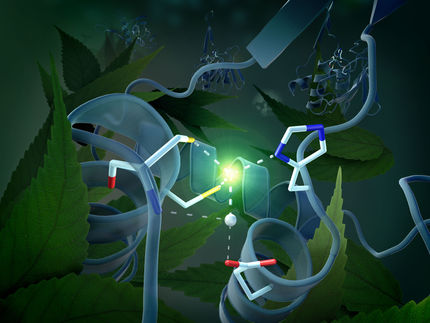Building Scaffolds in the Cell’s Power Stations
Researchers at the University of Freiburg discover a basic architectural principle of mitochondria
A group of scientists led by Assistant Professor Dr. Martin van der Laan has decoded the molecular basis for the characteristic structures inside of mitochondria. Mitochondria are the powerhouses of cells and contain microscopic, strongly infolded membrane structures. These structures allow mitochondria to use the energy gained from food effectively. A defect in the architecture of mitochondrial membrane folds can lead to serious disorders in the nervous and muscular system. The team of researchers from the University of Freiburg has now published a study in which it describes a sophisticated molecular structure made of membrane proteins. This structure allows mitochondria to develop their typical architecture while keeping the elaborate network of membrane folds stable.
A large complex of several protein components, called the MICOS complex (the acronym for mitochondrial contact site and cristae organizing system), plays a key role in the inner structure of mitochondria and was discovered by the same group of scientists from the University of Freiburg several years ago. For the current study, van der Laan’s team worked together with researchers from the University of Groningen in the Netherlands and the Max-Planck-Institute of Biophysics in Frankfurt to decode the blueprint and functions of the MICOS. They determined that Mic10, which is a component of the MICOS, plays a central role. Dr. Maria Bohnert, an expert in molecular medicine and biochemistry from the University of Freiburg, discovered a structure within the protein Mic10 that functions like a barcode. It contains information that describes where Mic10 belongs within the cell. It thus controls the transport of Mic10 and its insertion into the inner membrane system of mitochondria. When the protein has reached its final destination, a second characteristic structure of Mic10 enables it to join many identical copies together to create an extended protein scaffold that keeps the mitochondria's specialized membrane folds together.
If one of the two main structural elements in Mic10 is inactivated, parts of the membrane system collapse, leading to mitochondrial malfunction. On the other hand, if there is too much Mic10, an extreme expansion of the mitochondrial membrane folds occurs. “Our results show that Mic10 is the structural basis of MICOS. It is vital for building the small generators in the cell's power station,” Bohnert said. These discoveries could help scientists better understand many different disorders related to the defective construction of mitochondria and the partial loss of mitochondrial functions.
Scientists from Freiburg involved in this study work at the Institute of Biochemistry and Molecular Biology at the University of Freiburg and are members of the Cluster of Excellence BIOSS Centre for Biological Signalling Studies as well as the Collaborative Research Centre 746 "Functional Specificity by Coupling and Modification of Proteins". Bohnert is a post-doc researcher at the Institute for Biochemistry and Molecular Biology at the University of Freiburg.
Original publication
Maria Bohnert, Ralf M. Zerbes, Karen M. Davies, Alexander W. Mühleip, Heike Rampelt, Susanne E. Horvath, Thorina Boenke, Anita Kram, Inge Perschil, et al.: “Central Role of Mic10 in the Mitochondrial Contact Site and Cristae Organizing System."; Cell Metabolism, 2015.
Most read news
Original publication
Maria Bohnert, Ralf M. Zerbes, Karen M. Davies, Alexander W. Mühleip, Heike Rampelt, Susanne E. Horvath, Thorina Boenke, Anita Kram, Inge Perschil, et al.: “Central Role of Mic10 in the Mitochondrial Contact Site and Cristae Organizing System."; Cell Metabolism, 2015.
Organizations
Other news from the department science

Get the life science industry in your inbox
By submitting this form you agree that LUMITOS AG will send you the newsletter(s) selected above by email. Your data will not be passed on to third parties. Your data will be stored and processed in accordance with our data protection regulations. LUMITOS may contact you by email for the purpose of advertising or market and opinion surveys. You can revoke your consent at any time without giving reasons to LUMITOS AG, Ernst-Augustin-Str. 2, 12489 Berlin, Germany or by e-mail at revoke@lumitos.com with effect for the future. In addition, each email contains a link to unsubscribe from the corresponding newsletter.





















































